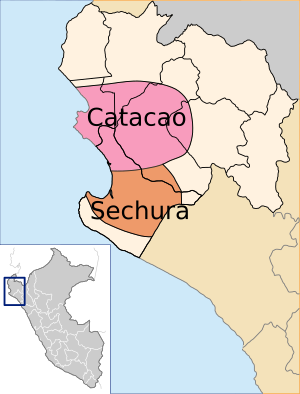| Sechura–Catacao | |
|---|---|
| Geographic distribution | Peru |
| Linguistic classification | Proposed language family |
| Subdivisions | |
| Language codes | |
| Glottolog | (not evaluated) |
 Distribution of Sechura and Catacaoan in the Piura region. Distribution of Sechura and Catacaoan in the Piura region. | |
Sechura–Catacao is a proposed connection between the small Catacaoan language family of Peru and the language isolate Sechura (Sek). The languages are extremely poorly known, but Kaufman (1990) finds the connection convincing, Campbell (2012) persuasive.
External relationships
Kaufman (1994: 64) groups Leco and Sechura–Catacao together as part of a proposed Macro-Lecoan family.
Tovar (1961), partly based on Schmidt (1926), classifies Sechura–Catacao together with the Chimuan languages in his Yunga–Puruhá family.
Vocabulary
Loukotka (1968) lists the following basic vocabulary items.
gloss Sechura Catacao Colan man rekla aszat yatadlam water xoto yup yúp fire morot guanararak hayur sun yóro nap turi nap moon ñangru nam nag bird yaibab yeya yaiau fish xuma l'as l'as head te-uma foot lava
Comparative word list of Sechura, Colan, and Catacao from Loukotka (1949):
- Notes
- (Sp.) = Spanish loanword (excluded)
- Sources used by Loukotka (1949)
- Sechura: Buchwald (1919)
- Manuscript by Martínez Compañón from the 1700s
French gloss
(original)English gloss
(translated)Sechura Kolan Katakao animal animal animblà (Sp.) (Sp.) arbre tree nusuču (Sp.) čiguasam boire drink tutuk kum konekuk ciel sky kučuk yor kutuk nap (Sp.) cœur heart čusiupunma ñessinim ñiesiñičim corps body kuerpokči (Sp.) (Sp.) douleur pain punuk masik masik eau water tutú yup yup étoiles stars čúpčúp čupučup (Sp.) femme woman kuktum pim pičim feu fire morot huyur guanararak fille daughter ñosñi hikum ykučim kapuk fils son ñosñi hikum ykučim fleur flower florak (Sp.) alhuaka fleuve river tuxut yup turuyup frère brother sikanñi puam puačim fruit fruit (Sp.) (Sp.) (Sp.) gai happy otmuk čagasiñ (Sp.) herbe grass unñiókól aguakol taguakol homme man sukda yatadlam aszat lune moon ñangru nag nam manger eat unuk agua aguačim mer sea roro amum amaum mère mother ñiña nun ničim mort dead laktukno dlakati ynataklakatu oiseau bird yaibab yaiau yeya ondes waves kaph llamas (Sp.) os bone ruño dladlapiram lalapečen père father xači mam (Sp.) pleurer cry nik ñar ñarakñakitutin pluie rain purir nug guayakinum poisson fish xum llas llas rameau branch (Sp.) yabitiram yabike régner reign busuk čañar čañak sœur sister bapueñi purum puručim soleil sun yóro turinap nap terre earth lokt dlurum durum tronc trunk fukú tukuram taksikás vent wind fik kuiat ñap vik viande meat kolt (Sp.) kkol
References
- ^ Kaufman, Terrence. 1994. The native languages of South America. In: Christopher Moseley and R. E. Asher (eds.), Atlas of the World’s Languages, 59–93. London: Routledge.
- Campbell, Lyle (2012). "Classification of the indigenous languages of South America". In Grondona, Verónica; Campbell, Lyle (eds.). The Indigenous Languages of South America. The World of Linguistics. Vol. 2. Berlin: De Gruyter Mouton. pp. 59–166. ISBN 978-3-11-025513-3.
- Tovar, Antonio (1961). Catálogo de las lenguas de América del Sur, pp. 162-165. Buenos Aires.
- Schmidt, Wilhelm (1926). Die Sprachfamilien und Sprachenkreise der Erde, p. 214. Heidelberg.
- Loukotka, Čestmír (1968). Classification of South American Indian languages. Los Angeles: UCLA Latin American Center.
- Loukotka, Čestmír. 1949. Sur Quelques Langues Inconnues de l'Amerique du Sud. Lingua Posnaniensis I: 53-82.
- Buchwald, Otto von. 1919. Migraciones sudamericanas. Boletín de la sociedad ecuatoriana de estudios historicos, vol 1, pp. 227-239. Quito.
- Kaufman, Terrence (1990). "Language History in South America: What we know and how to know more". In David L. Payne (ed.). Amazonian Linguistics. Austin: University of Texas Press.
| Indigenous language families and isolates of South America (based on Campbell 2012 classification) | |||||||||||||||||||||||||||||||
|---|---|---|---|---|---|---|---|---|---|---|---|---|---|---|---|---|---|---|---|---|---|---|---|---|---|---|---|---|---|---|---|
| Language families and isolates |
| ||||||||||||||||||||||||||||||
| Proposed groupings |
| ||||||||||||||||||||||||||||||
| Linguistic areas | |||||||||||||||||||||||||||||||
| Countries | |||||||||||||||||||||||||||||||
| Lists | |||||||||||||||||||||||||||||||